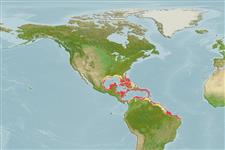>
Ovalentaria/misc (Various families in series Ovalentaria) >
Pomacentridae (Damselfishes) > Microspathodontinae
Etymology: Stegastes: Greek, stegastos, -e, -on = covered (Ref. 45335).
More on author: Poey.
Environment: milieu / Zona climática / intervalo de profundidade / distribution range
Ecologia
marinhas associadas(os) a recifes; não migratória; intervalo de profundidade 0 - 100 m (Ref. 9626). Tropical; 33°N - 5°S, 98°W - 34°W
Western Atlantic: including southern Florida (USA), Bahamas, and the Caribbean. Probably extending to Brazil (Ref. 9626).
Tamanho / Peso / Idade
Maturidade: Lm ? range ? - ? cm
Max length : 10.0 cm TL macho/indeterminado; (Ref. 26340)
Descrição suscinta
Chaves de identificação | Morfologia | Morfometria
Espinhos dorsais (total) : 12; Raios dorsais (total) : 14 - 17; Espinhos anais: 2; Raios anais : 13 - 15. Exhibits geographic color variations (Ref. 7247). Body dark in front, becoming abruptly yellow between last dorsal spine and anal fin origin (Ref. 26938).
Body shape (shape guide): fusiform / normal; Cross section: compressed.
Adults inhabit shallow coral reefs and isolated patch reefs in deeper water. Feed primarily on algae but also on polychaetes, hydroids, copepods and ascidians (Ref. 9626). Aggressively territorial but only around a small area (Ref. 9710). Oviparous, distinct pairing during breeding (Ref. 205). Eggs are demersal and adhere to the substrate (Ref. 205). Males guard and aerate the eggs (Ref. 205). Taken incidentally in traps and small-meshed beach nets (Ref. 5217).
Ciclo de vida ou comportamento de acasalamento
Maturidade | Reprodução | Desova | Ovos | Fecundidade | Larvas
Oviparous, distinct pairing during breeding (Ref. 205). Eggs are demersal and adhere to the substrate (Ref. 205). Males guard and aerate the eggs (Ref. 205). This species has a juvenile bisexual condition and a typical gonochore testis (Ref. 103751).
Allen, G.R., 1991. Damselfishes of the world. Mergus Publishers, Melle, Germany. 271 p. (Ref. 7247)
Status na Lista Vermelha da UICN (Ref. 130435: Version 2025-1)
Ameaça para os humanos
Harmless
Uso pelos humanos
Pescarias: espécies comerciais; Aquário: Espécies comerciais
Ferramentas
Relatórios especiais
Baixar XML
Fontes da internet
Estimates based on models
Preferred temperature (Ref.
123201): 24.2 - 28, mean 26.9 °C (based on 262 cells).
Índice de diversidade filogenética (Ref.
82804): PD
50 = 0.5000 [Uniqueness, from 0.5 = low to 2.0 = high].
Bayesian length-weight: a=0.01230 (0.00566 - 0.02674), b=3.06 (2.86 - 3.26), in cm total length, based on LWR estimates for this species & (Sub)family-body (Ref.
93245).
Nível Trófico (Ref.
69278): 2.0 ±0.00 se; based on food items.
Resiliência (Ref.
120179): Elevada, tempo mínimo de duplicação da população menor que 15 meses (Preliminary K or Fecundity.).
Fishing Vulnerability (Ref.
59153): Low vulnerability (10 of 100).
🛈
Nutrients (Ref.
124155): Calcium = 123 [65, 204] mg/100g; Iron = 0.889 [0.533, 1.467] mg/100g; Protein = 18.2 [17.1, 19.3] %; Omega3 = 0.157 [0.098, 0.256] g/100g; Selenium = 30.7 [16.8, 59.7] μg/100g; VitaminA = 111 [31, 375] μg/100g; Zinc = 2.37 [1.62, 3.37] mg/100g (wet weight);
